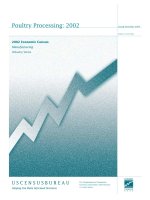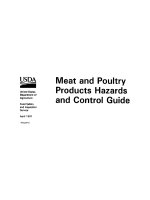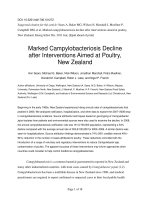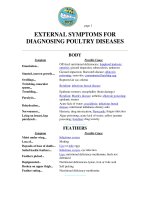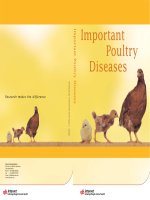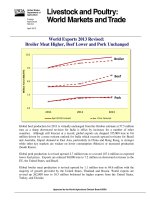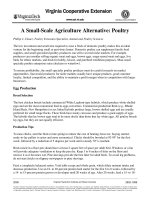IMPORTANT POULTRY DISEASES pdf
Bạn đang xem bản rút gọn của tài liệu. Xem và tải ngay bản đầy đủ của tài liệu tại đây (1.7 MB, 88 trang )
Important Poultry Diseases
Important
Poultry
Diseases
Research makes the difference
060058 © 2009, Intervet International bv, The Netherlands.
IMPORTANT POULTRY DISEASES
Contents
Foreword 3
Infectious respiratory Diseases
Chronic Respiratory Disease 7
Coryza 10
Aspergillosis 12
Newcastle Disease 14
Infectious Bronchitis 16
Infectious Laryngotracheitis 18
Avian Influenza 20
Pneumovirus 22
Neoplastic Diseases
Lymphoid Leucosis 27
Marek’s Disease 29
Avian Adenoviral Diseases
Inclusion Body Hepatitis 35
Egg Drop Syndrome ’76 38
Miscellaneous viral Diseases
Fowl Pox 43
Avian Encephalomyelitis 45
Infectious Bursal Disease 47
Reovirus infection 49
Malabsorption Syndrome 51
Infectious Anaemia 53
Miscellaneous Bacterial Diseases
Infectious Synovitis 57
Fowl Cholera 59
Pullorum Disease/Fowl Typhoid 61
Ornithobacterium Rhinotracheale infection 63
1
Infectious Viral Diseases of ducks
Duck Virus Hepatitis 67
Duck Plague 69
Parasitic Diseases
Coccidiosis 73
Endoparasites 78
Blackhead 80
Deficiency Diseases
Riboflavin 85
Vitamin E 86
Vitamin D3 87
2
Foreword
We first published the “Important Poultry Diseases ”
in 1972 and, ever since, it has remained the most
sought after of all our publications.
However, in the intervening years new causes of disease such
as chicken anemia virus and pneumovirus were identified.
Therefore, Intervet Research teams developed new vaccines
to combat the changed pattern of diseases. Many of these
are inactivated vaccines, in either single or combined form,
resulting in new vaccination programmes. We have, therefore,
produced this fourth edition of the handbook to cover these
developments. It is intended as a pocket reference book for
people working with poultry.
It is not highly academic as it is written from a practical angle
to assist with every day problems in the field.
Intervet Research continues to co-operate with the poultry
industry, worldwide, to stay ahead of disease problems.
The farmer who uses an Intervet vaccine can do so knowing
that it is the best product available.
For detailed information on any of our products contact the
local Intervet representative or
Intervet International BV
Boxmeer- Holland
P.O. Box 31
5830 AA Boxmeer, The Netherlands
Phone +31 485 58 76 00
Fax +31 485 57 73 33
Telex 37306 inte nl
www.intervet.com
3
4
INFECTIOUS RESPIRATORY
DISEASES
• Chronic Respiratory Disease (CRD)
• Coryza
• Aspergillosis
• Newcastle Disease (ND)
• Infectious Bronchitis (IB)
• Infectious Laryngotracheitis (ILT)
• Avian Influenza
• Turkey Rhinotracheitis/Swollen
Head Syndrome
5
6
Chronic respiratory Disease
(CRD) (Airsacculitis)
Cause
The underlying cause of CRD is Mycoplasma gallisepticum
(Mg). The condition is frequently triggered by respiratory viru-
ses such as ND and IB and subsequently complicated by bac-
terial invasion. The main agents involved in the infection are
Mycoplasma gallisepticum and E. coli. Stress caused by
moving the birds, by debeaking or other operations or other
unfavorable conditions e.g. cold or bad ventilation, make the
birds more susceptible.
Transmission
The main problem is that parent birds infected with
Mycoplasma gallisepticum can transmit the organism through
the egg to their offspring. In addition, infection can occur by
contact or by airborne dust or droplets. The incubation
period varies from 4 days to 3 weeks.
Species affected
Chickens and turkeys.
7
Airsacculitis
Clinical signs
Young chickens (broiler chicks or layer pullets) will show
respiratory distress. The birds frequently show a lack of
appetite, decreased weight gain and increased feed conver-
sion ratios.
In adult birds the most common symptoms are sneezing,
coughing and general signs of respiratory congestion. In
laying birds a drop of egg production between 20-30 % can
occur.
CRD does not normally cause an alarming number of deaths.
The effect is more of a chronic nature causing reduced weight
gain and feed conversion ratios in broilers and lower egg pro-
duction in breeders and layers. In this way the overall econo-
mic loss can be very great in broilers but less dramatic in
breeders and layers.
Internal lesions
A reddish inflamed trachea and/or cheesy exudate in airsacs,
especially in complicated cases (e.g. with secondary E. coli
infections) are observed. In mild Mg infections the only lesion
might be slight mucus in trachea and a cloudy or light froth
in the airsacs.
Turkeys with Mg infection usually have swollen sinuses under
the eyes.
Diagnosis
Diagnosis of Mg infection can be made by blood testing of
chickens, post-mortem examination and ultimately by
isolating the causative Mg organism from tracheas or airsacs
of affected birds.
8
Differential diagnosis
Respiratory virus infection (Newcastle disease or infectious
bronchitis) with secondary infection (E. coli, etc.) can give
similar lesions.
Treatment
Treatment of Mg-infected chickens or turkeys with suitable
antibiotics or chemotherapeutics has been found to be of
economic value. However, control by medication or vaccina-
tion and eradication of Mg infections has been by far the
most effective method of combating the disease. Fertile eggs
from infected birds can be treated with antibiotics such as
tylosin to eliminate the Mycoplasma gallisepticum organisms.
Methods used are the injection of fertile eggs or egg dipping.
Blood serum testing of breeder chickens for Mg antibodies
has become a routine to test flocks for a Mg infection.
9
Pericarditis, peritonitis and
perihepatitis is frequently observed
in birds with CRD
Infectious Coryza
Cause
The bacterium causing this disease is Hemophilus paragalli-
narum.
Transmission
The disease spreads from bird to bird and flock to flock by
contact and airborne infected dust particles and via the
drinking water.
Spread by equipment and personnel has also been reported.
The incubation period varies from 1 to 3 days.
Species affected
Chickens appear to be the only natural hosts of
H. paragallinarum.
Clinical signs
The main signs of the disease are inflammation of eyes and
nose with foul-smelling discharges, conjunctivitis, sneezing
and facial swellings. Feed and water intake is reduced,
leading to loss of weight. Egg production in laying birds will
drop.
Mortality will vary with the virulence of the infection but is
generally low.
10
11
Diagnosis
A field infection produces similar symptoms to chronic
respiratory disease, a diagnosis is difficult to establish.
The most certain diagnosis may be obtained by the isolation
of the organism from the sinus or airsac exudate from
affected birds. This procedure must be carried out in the
laboratory.
Treatment and control
Treatment with antibiotics can be given to subdue clinical
infection, but eradication and prevention are the most
desirable means of control of coryza. Vaccines have been
developed, but are only used in areas where the disease is
endemic and cannot be eradicated.
Typical facial edema
Aspergillosis (Fungal Pneumonia)
Cause
The disease is caused by a fungus, Aspergillus fumigatus.
Transmission
Transmission is by inhalation of fungus spores from
ontaminated litter (e.g. wood shavings) or contaminated feed.
Hatcheries may also contribute to infection of chicks.
Species affected
Young chicks are very susceptible, older chickens are more
resistant to infection. Turkey poults, pheasant chicks, quail
chicks, ducklings, and goslings may also become infected.
Clinical signs
Infected chicks are depressed and thirsty. Gasping and rapid
breathing (“pump handle breathing”) can be observed.
Mortality is variable, from 5 to 50 %.
Gross lesions involve the lungs and airsacs primarily. Yellow-
white pinpoint lesions can be found. Sometimes all body
cavities are filled with small yellow-green granular fungus
growth.
12
Diagnosis
The presence of Aspergillus fumigatus can be identified
microscopically or sometimes even with the naked eye in the
air passages of the lungs, in the airsacs or in lesions of the
abdominal cavity.
Treatment and control
There is no treatment for aspergillosis. Affected chicks
should be removed and destroyed. Strict hygiene in breeder
and hatchery management is necessary. Choice of litter
material is important so that no spore-bearing wood shavings
are used.
13
Gross lesions
of the lungs
Newcastle Disease (ND)
Cause
Newcastle disease is caused by a paramyxovirus. Only one
serotype of ND is known. ND virus has mild strains (lentoge-
nic), medium strength strains (mesogenic), and virulent
strains (velogenic).
The strains used for live vaccines are mainly lentogenic.
Transmission
Newcastle disease virus is highly contagious through infected
droppings and respiratory discharge between birds. Spread
between farms is by infected equipment, trucks, personnel,
wild birds or air. The incubation period is variable but usually
about 3 to 6 days.
Species affected
Chickens and turkeys.
Clinical signs
Newcastle disease causes high mortality with depression and
death in 3 to 5 days as major signs. Affected chickens do not
always exhibit respiratory or nervous signs.
Mesogenic strains cause typical signs of respiratory distress.
Labored breathing with wheezing and gurgling, accompanied
by nervous signs, such as paralysis or twisted necks (torticol-
lis) are the main signs. Egg production will decrease 30 to 50
% or more, returning to normal levels in about 2 weeks. Eggs
may have thin shells and eggs without shells may also be
found. In well-vaccinated chicken flocks clinical signs may be
difficult to find.
14
Internal lesions
Inflamed tracheas, pneumonia, and/or froth in the airsacs are
the main lesions. Haemorrhagic lesions are observed in the
proventriculus and the intestines.
Diagnosis
Is made by virus isolation from tracheal or cloacal swabs
together with blood testing to demonstrate high antibody
levels. Infectious bronchitis or infectious laryngotracheitis can
give similar clinical signs, but lesions, blood tests, and virus
isolation tests are decisive.
Treatment and control
There is no treatment for Newcastle disease. Vaccination
against ND with live and/or inactivated (killed) adjuvant
vaccines is the only reliable control method.
15
Neurotropic form of ND
Haemorrhagic proventriculus
Infectious Bronchitis (IB)
Cause
Corona-virus is the causal agent. Several different serotypes
of IB virus are known to exist.
Transmission
The virus is transmitted from bird to bird through the
airborne route. The virus can also be transmitted via the air
between chicken houses and even from farm to farm.
Species affected
Only chickens are susceptible to IB virus.
Clinical signs
In young chicks IB virus infection causes a cheesy exudate
in the bifurcation of the bronchi, thereby causing asphyxia,
preceded by severe respiratory distress (“pump handle”
breathing). In older birds IB does not cause mortality. Egg
production will decrease dramatically, deformed eggs with
wrinkled shells will often be laid.
16
Respiratory
symptoms of IB
in chickens
Internal lesions
Mucus and redness in tracheas, froth in airsacs in older
chickens. In young chicks a yellow cheesy plug at the tracheal
bifurcation is indicative of IB infection.
Diagnosis
There are three main factors to be considered in order to
arrive at a diagnosis.
a. The clinical picture including post-mortem findings in the
flock.
b. Isolation of the virus in the laboratory.
c. A rising antibody titre when the serum is tested against
a known strain of bronchitis virus.
Treatment and control
There is no treatment for infectious bronchitis.
Secondary bacterial infections may be prevented by, or
treated with antibiotics.
Prevention by vaccination is the best method to control IB.
17
Misshapen, shellless and
normal eggs
Infectious Laryngotracheitis
(ILT)
Cause
ILT is caused by a virus belonging to the herpes group. Only
one serotype is known.
Transmission
Field infection occurs from bird to bird by the respiratory
route. Most outbreaks of ILT on farms are traced back to
transmission by contaminated people or equipment (visitors,
shoes, clothing, egg boxes, used feeders, waterers, cages,
crates etc.). The incubation period varies from 4 to 12 days.
Species affected
Chickens and pheasants are natural hosts for ILT.
Clinical signs
Respiratory distress is usually quite pronounced due to build
up of blood, sloughed tracheal lining and even caseous exu-
date in larynx and trachea. When a caseous plug occludes the
larynx or trachea, the affected chickens will have extreme
difficulty breathing (“pump handle” breathing) and will
frequently die from suffocation. Mortality is approximately
1 % per day in a typical ILT outbreak. Milder forms of ILT
outbreaks occur where less virulent strains of ILT virus are
involved. Conjunctivitis and respiratory sounds (wheezing)
can be observed, with little or no mortality in such cases.
18
Haemorrhagic
lesions in trachea
The disease spreads through a chicken house more slowly
than either IB or ND. Egg production in laying flocks will
usually decrease 10 to 50 %, but will return to normal after
3 to 4 weeks.
Diagnosis
In a chicken flock, spreading of respiratory distress, with pos-
sible coughing up of blood and mortality is indicative of ILT.
Bloody mucus and cheesy exudate can be found in larynx and
trachea. In the laboratory a definite diagnosis can be made by
histological examination of tracheal tissues or virus isolation
from tracheal mucus in embryonated chicken eggs.
Treatment and control
Prevention of ILT by vaccination with mild eye-drop vaccine is
by far the best control method. Sometimes such vaccines are
applied by drinking water or spray methods with variable
success. Even when an outbreak of ILT has been detected in a
chicken flock, immediate vaccination is advisable to stop the
spread of infection.
19
Some birds show
symptoms of gasping
with the head extended
and the beak open
Avian Influenza
Cause
Avian influenza is caused by a myxovirus. There are several
serotypes.
Transmission
Airborne virus particles from the respiratory tract, droppings,
and people-carrying virus on their clothing and equipment
are the main routes of transmission.
Species affected
Turkeys and ducks are mainly affected but chickens, geese,
and wild birds can also be infected.
Clinical signs
Clinical signs may vary, depending on the type of influenza
virus. Respiratory disease with mortality in turkeys has been
observed, but a drop in egg production without clinical signs
has also been seen in chickens. Swelling of the head and
neck, swollen sinuses with nasal discharge can be seen with
respiratory involvement.
Mortality is usually low. Fowl plague, also an avian influenza,
is an exception to the rule in that it causes high mortality in
turkeys and chickens.
20
Influenza in turkeys
Diagnosis
A laboratory diagnosis is necessary by serological (agar gel
precipitation AGP) or virological methods (virus isolation).
Avian influenza can be confused with Newcastle disease,
fowl pox, Mycoplasma infection, Staphylococcus, or other
respiratory or systemic infections.
Treatment and control
There is no treatment for avian influenza. Antibiotics will help
prevent secondary bacterial infections.
21
AI infected heart
and proventriculus
Pneumovirus Infections
(Turkey Rhinotracheitis/Swollen Head
Syndrome)
Cause
The disease is caused by a pneumovirus.
Transmission
The virus may be transmitted horizontally by contaminated
water, personnel and equipment as well as from bird to bird.
Species affected
Turkeys and chickens.
Clinical signs and lesions
In young turkeys sneezing. Rales and nasal discharge, con-
junctivitis, swelling of the infraorbital and submandibular
sinuses can be seen.
In laying flocks a drop in production may occur along with
respiratory distress. Morbidity is high whereas mortality may
vary being usually higher in young poults. In chickens the
pneumovirus may be involved in the so called “swollen head
syndrome” (SHS). In such cases affected chickens may show
swelling of the periorbital and infraorbital sinuses, torticollis,
cerebral disorientation and depression. Marked egg produc-
tion losses can be associated with SHS.
At necropsy the lesions seen may vary due to other microor-
ganisms that may complicate the original picture. In cases of
SHS apart from oedema in the head also purulent or caseous
subcutaneous exudate can be found. Rhinitis, tracheitis and
sinusitis are frequently noted in both chicken and turkeys,
hence also the name turkey rhinotracheitis (TRT).
Poliserositis affecting the air sacs and pericardium may be
due to secondary infections (E. coli). The kidneys may be
swollen and congested as well as the lungs which may show a
fibrinous exudate in the pleural cavity.
22
Diagnosis
The diagnosis based only on clinical signs is difficult to
establish since other agents may be involved. The most
certain diagnosis may be obtained by the isolation of the
organism from nasal secretions or tissue scraped from the
sinus of affected birds. Antibodies can be detected by several
serological methods such as the VN test, IFT and ELISA.
Treatment and control
Treatment with antibiotics can be given to control secondary
bacterial infections. The use of vaccines should be the best
approach to control the disease.
23
Swollen head
syndrome
Young turkey
with conjunctivitis
and sinusitis
24

